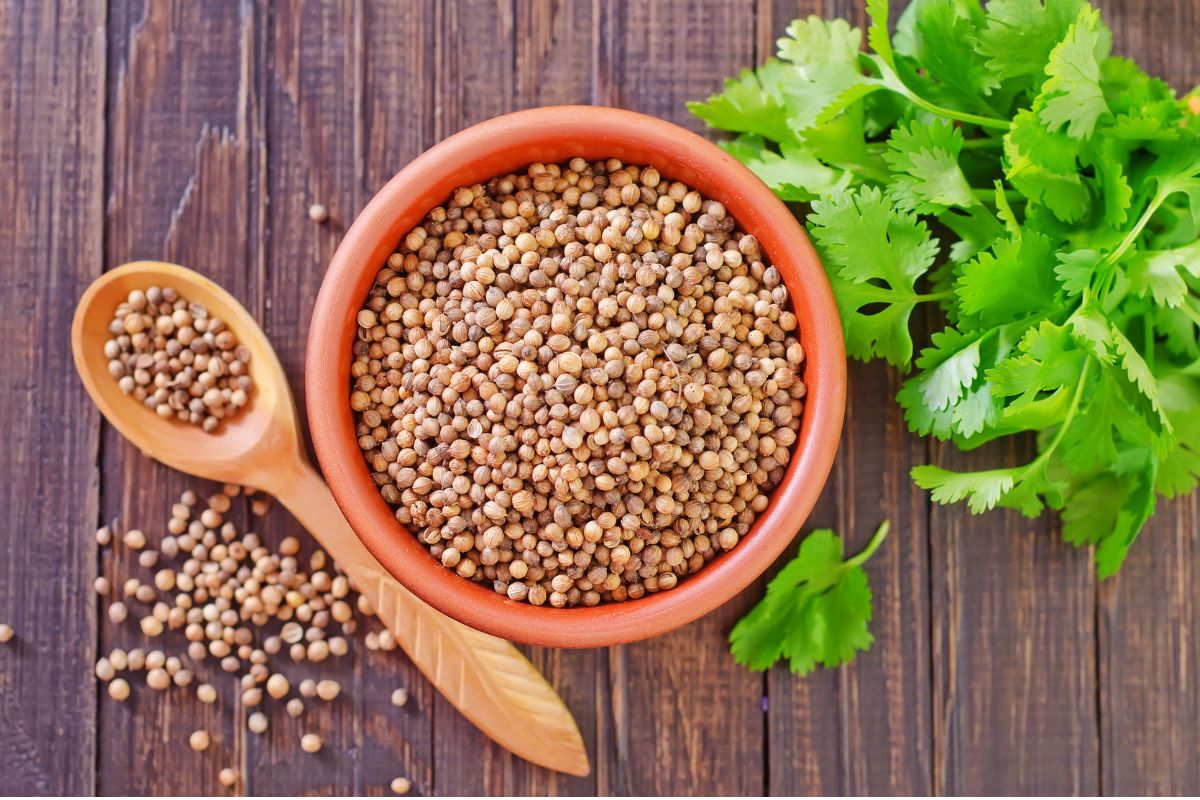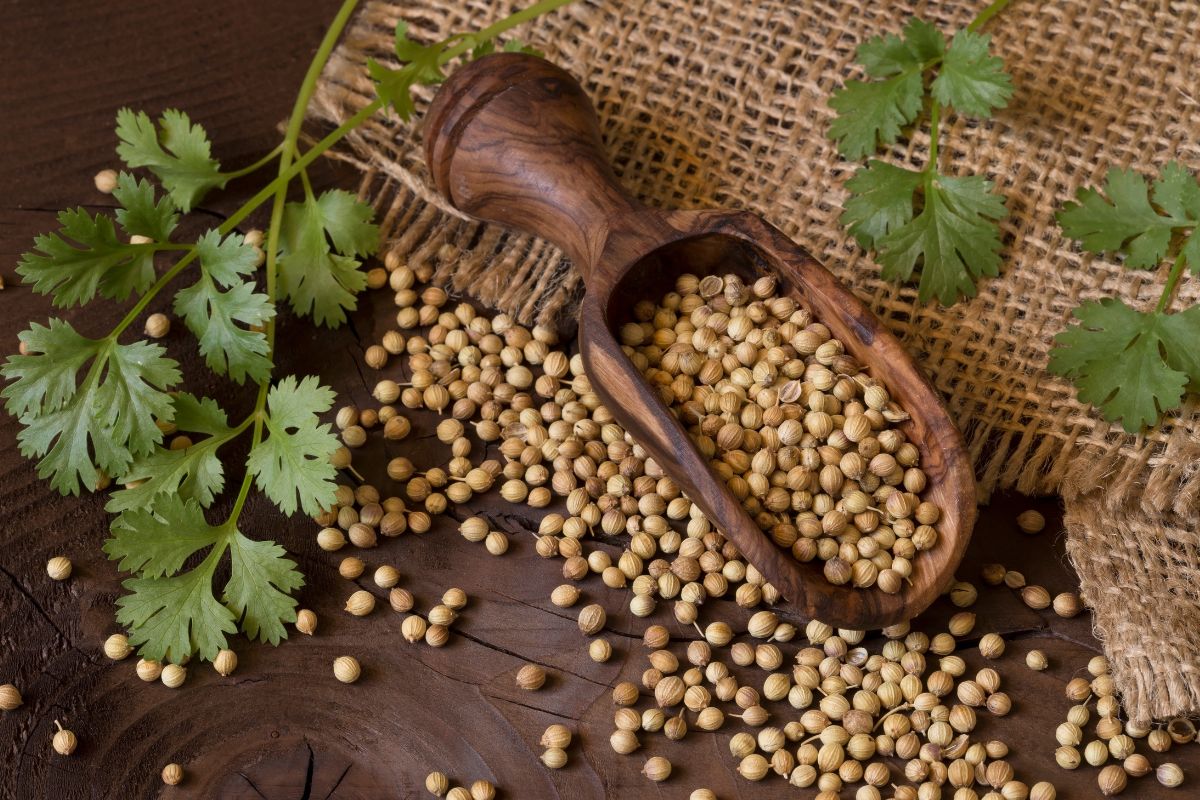The terms cilantro and coriander are often used interchangeably, leading to confusion among both amateur and experienced cooks. Are they the same thing, or do they refer to distinct ingredients?

Cilantro and coriander are derived from the same plant, but they are not the same. Cilantro typically refers to the plant’s leafy green herb, while coriander denotes the plant’s dried seeds or ground spice.
While cilantro and coriander originate from the same plant, their contrasting tastes and culinary applications set them apart. Understanding the disparity between these two components is crucial for achieving the desired flavors in various recipes.
In this article, we will take a closer look at cilantro and coriander. We will look at their differences and uses. By the end of this article, you will know all there is to know about cilantro and coriander!
The Different Between Cilantro And Coriander
The main difference between cilantro and coriander is their flavor and taste. Cilantro has a very fragrant and citrusy flavor, however, many people have a genetic disposition to perceive cilantro as having a soapy flavor instead.
In comparison, coriander has a nuttier and spicier flavor. It also has a citrusy flavor but interestingly, isn’t perceived as soapy by those who find cilantro to have that taste.
Let’s now take a closer look at the similarities and differences between cilantro and coriander.
What Are Cilantro And Coriander?
Both cilantro and coriander come from the same plant species. This is the Coriandrum sativum, which is a delicate and leafy green plant that can reach heights of around 20 inches (50 cm.)
The coriander plant has extensive lobed leaves at its base, while the leaves become slender and feathery at the higher reaches of the blooming stalks.
The plant produces flowers in small asymmetrical umbels and these are either pale pink or white. These flowers have a greater number of petals facing outward from the center of the umbel compared to those facing inward.
As the flowers fade, they give rise to spherical green fruits that contain an abundance of seeds.
Cilantro and coriander are commonly confused. This is because different regions of the world use the words differently.
In North America, we use the word “cilantro” to refer to the leaves and the stalk of the plant. The seeds that are produced by the plant are called “coriander”
Internationally, however, these terms are often different! In many countries, “cilantro” isn’t used at all. Instead, the leaves are called “coriander” and the seeds are known as “coriander seeds.”
This means that both “cilantro” and “coriander” are used for the leaves depending on where in the world you are. This can make following recipes complicated at times as recipes written by non-Americans may use the word “coriander” when they refer to the leaves.
For this article, we will use the standard North American terms. So we will use “cilantro” for the leaves and “coriander” for the seeds.
Etymology Of Cilantro
Cilantro is the Spanish word for coriander. It was adopted in North America for the leaves of the Coriandrum sativum plant because of how common cilantro is in Mexican cuisine.
Etymology Of Coriander
The word coriander comes from Coriandrum sativum, the Latin name for the plant. The main origin of the word can be traced all of the way back to Greek and the word koris.
In Greek, this means “stink bug” and it’s thought that this word was used for the plant because of the aroma of the plant.
How Is Cilantro Used?
There are many different ways that the cilantro leaves and stems can be used. The green leaves are classed as a herb commonly used as greenery in salads, where they will add some great flavor.
The leaves can also be chopped and used in a variety of sauces. For example, many different types of chutneys, salsas, marinades, dressings, and pestos use cilantro. The plant can add a depth of flavor and aroma that really makes these stand out.
The stems are often chopped and used in curries, soups, and stews. They have a very similar flavor to the leaves and serve the same purpose but can stand up to the heat and cooking process more effectively.
It’s also possible to make herbal tea from cilantro leaves by simply adding hot water. Cilantro tea is supposed to be good for your digestion and metabolism, especially if drunk in the morning.
When drunk later in the day, it can help with a restful night’s sleep.
How Is Coriander Used?

Coriander seeds are considered a spice and can be used in a variety of different ways. It’s not the most common of spices, but you can find many recipes that call for coriander.
It can be used as part of a mix of herbs to make a delicious marinade for different meats and is especially delicious when used with pork chops.
Ground coriander seed can also be used to add some flavor to many types of soup and a little bit added mixed with white peppercorn tastes great on salads and vegetables.
How To Store Cilantro
Cilantro is a fresh herb and needs to be stored correctly to remain fresh. The best way to store them is to treat them in a similar way to how you would treat live plants and flowers.
Cut off the bottom of the stems and place them into a jar or glass that is partially filled with water. The stem should be fully submerged but the leaves out of the water.
You can then leave the jar in your kitchen or to keep it extra fresh, you can put it in the fridge. We recommend using the fridge as cilantro prefers cool temperatures. If you are going to put it in the fridge, cover the plant loosely with a plastic bag.
If the water begins to discolor, replace it with fresh water. You can keep cilantro for two weeks when stored in this manner.
How To Store Coriander
As coriander is in the format of seeds and is a spice, it will naturally last a long time. Spices don’t go bad, they just lose their flavor and aroma as time progresses.
Typically, ground coriander will remain fresh for around two to three years and dried coriander can manage three to four years.
To keep your coriander in its best condition for as long as possible, keep it in an air-tight container and away from any light.
Cilantro Vs Coriander Comparison Table
| Category | Cilantro | Coriander |
| Part of Coriandrum sativum | Leaves and stalk | Seeds |
| Name etymology | Spanish for “coriander” | Greek word koris (“stink bug”) |
| Average serving | Quarter of a cup | One tablespoon |
| Appearance | Green leaves | Hard seeds |
| Class | Herb | Spice |
| Common use | Garnish, sauces, dips, tea | Marinades, dip, seasoning |
| Storage | In water and the fridge | Air-tight container, dark |
Nutritional Content Breakdown: Which One Is Healthier?
Let’s take a look at the nutritional content of both cilantro and coriander. For this table, we’re going to look at the nutritional breakdown of 4 grams of each.
As there is a great discrepancy in the volume and weight of cilantro and coriander, this works out to about a quarter of a cup of cilantro but only one tablespoon of coriander seeds. These are both very average servings.
As you can see from the figures in the table below, although cilantro and coriander are sourced from the same plant, they do vary in their nutritional value in several different ways.
Although neither is particularly high in calories, coriander is higher in caloric content. This naturally leads to coriander also being higher in both carbs and fat.
Both of these values are still relatively low though, so unless you’re being very strict about your intake of carbs and fat, neither cilantro nor coriander should be a worry!
The amount of sodium and sugar contained in both is very similar and they have no sugar in them at all. Coriander is higher in protein and especially fiber, so if you need more fiber in your diet, coriander is a better choice.
However, if you need to avoid potassium, you should opt for cilantro. Coriander has over three times as much potassium as cilantro does.
This pattern is reflected in many different minerals as coriander is also significantly higher in calcium, iron, phosphorus, magnesium, and selenium.
For many people, this will make coriander a better choice. You will get a higher amount of your recommended daily intake of these minerals if you choose coriander over cilantro.
On the other hand, Cilantro is a great source of Vitamin A, especially when compared to coriander.
| Category (4 grams) | Cilantro | Coriander |
| Calories | 0.9 | 14 |
| Carbs | 0.2g | 0.8g |
| Fat | 0g | 0.8g |
| Sodium | 1.8mg | 1.6mg |
| Potassium | 20.8mg | 63.4mg |
| Protein | 0.1g | 0.8g |
| Fiber | 0.1g | 1.6g |
| Sugar | 0g | 0g |
| Vitamins and Minerals | ||
| Calcium | 2.7mg | 24mg |
| Iron | 0.1mg | 0.29mg |
| Phosphorous | 1.9mg | 20.5mg |
| Magnesium | 1mg | 16.5mg |
| Zinc | 0mg | 0.2mg |
| Copper | 0mg | 0mg |
| Selenium | 0.5mcg | 1.3mcg |
| Manganese | 0mg | 0.1mg |
| Vitamin A | 13.5mcb | 0mcb |
| Vitamin C | 1.1mg | 1.1mg |
Can Cilantro And Coriander Be Substituted For Each Other?
You might be wondering whether you can use cilantro and coriander interchangeably. If a recipe calls for cilantro but you only have coriander, can coriander be used instead?
The answer to this is no, they can’t be substituted for each other. They have different flavor profiles and are used in different ways, so using coriander seeds instead of cilantro (or vice versa) will not work.
If you are using a recipe that requires coriander but using seeds in that place seems strange, we recommend checking who has written the recipe.
Remember, some parts of the world use the word “coriander” when they mean cilantro so it may be a difference in language. If you accidentally use coriander when cilantro is required, you will not get a good result!
Conclusion
In this article, we took a closer look at the similarities and differences between cilantro and coriander.







